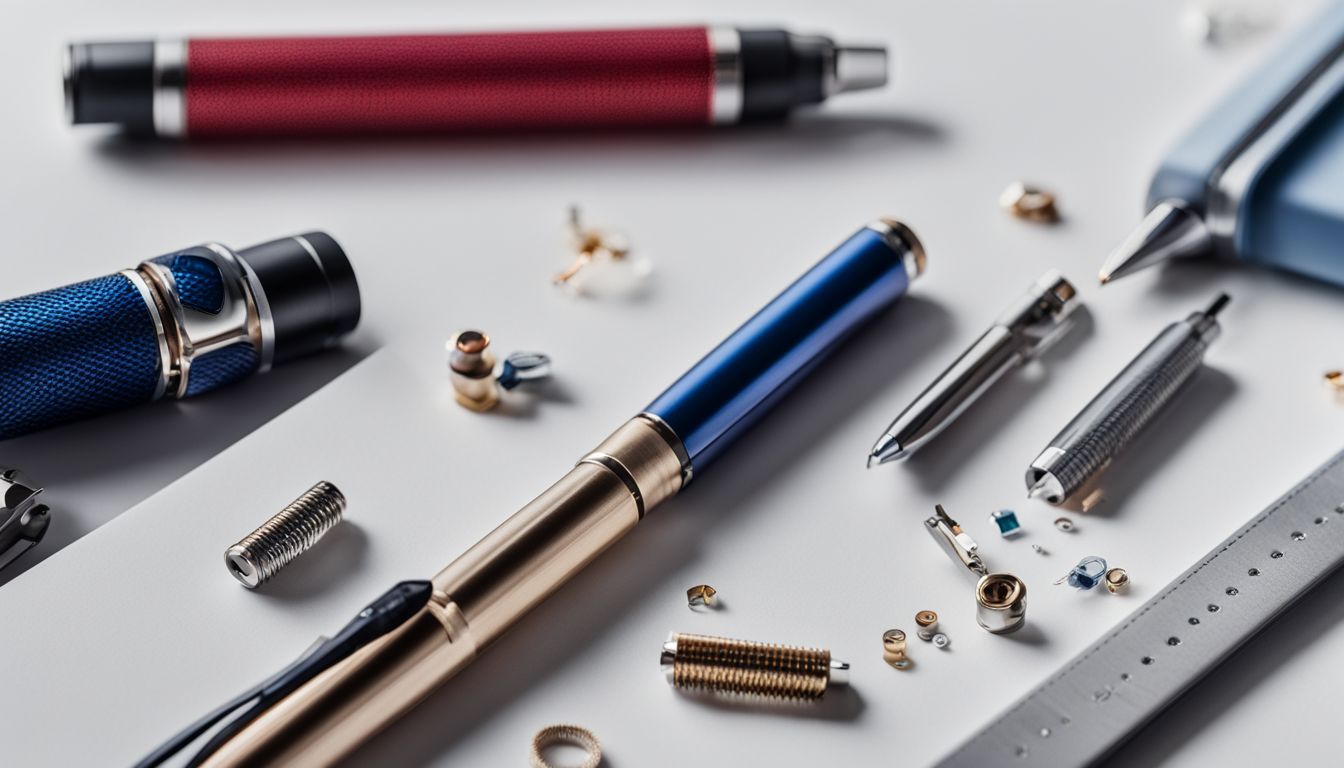Ever found yourself staring blankly at a page, with your pen poised but no words coming out? Believe me, you’re not alone—the frustration is something many of us know all too well.
That’s what prompted me to plunge into the nitty-gritty of these essential writing companions. I’m here to unveil insights and offer solutions for those all-too-common ink dilemmas, sharing the hidden truths about our beloved pens.
Let this guide be your beacon through the murky waters of writer’s block and reluctant ballpoints. Ready for an eye-opening journey? Let’s dive in!
Key Takeaways
- A ballpoint pen’s ink is oil – based and dries quickly, preventing smudges. It has a small metal ball that rolls out ink evenly as you write.
- You can fix a ballpoint pen that stops working by scribbling on paper, using rubbing alcohol, or heating the tip briefly with a lighter.
- Ballpoint pens can last for up to 50,000 words or around 100 pages. They can also be refilled when the ink runs out, which helps the environment.
- When choosing a ballpoint pen, consider the tip size for different line thicknesses and pick an ink color that suits your task. Comfortable grip and smooth writing are key factors.
- Store your ballpoint pen with the point down and cover it with a cap when not in use to prevent drying out and ensure it lasts longer.
The Anatomy of a Ballpoint Pen

Understanding the Ballpoint Pen Structure is crucial for knowing how these writing instruments work. From the metal ball to the ink reservoir, each component plays a role in delivering smooth and consistent ink flow.
Ever wondered how the ball stays in the pen or how ink comes out of a ballpoint pen? Let’s dive into this fascinating mechanism!
Understanding the Ballpoint Pen Structure
A ballpoint pen might look simple, but it’s actually a pretty clever little gadget. Inside, there’s a small metal ball—usually made of steel, brass, or tungsten carbide—that fits snugly into a socket at the pen’s tip.
This tiny sphere is super important; it rolls around as you write and gets ink onto your paper.
The magic really happens inside the ink reservoir. That’s where the paste-like ink hangs out until you’re ready to jot down your thoughts or doodle in the margins of your notebook.
As the ball at the point spins across your page, it picks up this special oil-based ink from inside and transfers just enough onto whatever you’re writing on. Plus, since that ink dries fast once it hits air, you won’t end up with smudges everywhere.
It’s like having a mini painting roller doing art on paper — neat and controlled!
How the ball stays in the pen
The ball in a ballpoint pen is pretty clever. It sits snug in a socket that László Bíró came up with. This tiny ball rolls around as I write, keeping the ink from just pouring out.
Gravity doesn’t get to boss it around either, so my pen writes smooth no matter which way I turn it.
It’s like a little magic trick right at the tip of my pen. The rolling action lets controlled amounts of ink flow onto paper and then seals it back up tight when I’m done writing. That way, there’s no mess or smudging and every word looks sharp on the page.
How ink comes out of a ballpoint pen
I love how cleverly a ballpoint pen works. As I write, the small metal ball at the pen’s tip rolls across the paper. This movement transfers ink from inside the pen right onto my page.
It’s like a mini printing press in my hand! The metal ball is pretty tough, often made of steel or tungsten carbide, so it can handle all my note-taking without wearing down.
The cool part is that this little ball also acts as a cap to keep the ink from drying out when I’m not writing. It seals off air while letting just enough ink roll out to create clear lines on paper.
No wonder these pens are perfect for jotting down quick thoughts or scribbling detailed drawings – they lay down smooth and dry super fast!
The Science Behind Ballpoint Pens
Ballpoint ink is typically composed of pigment, solvent, and a small percentage of binder material to hold the ink together. The viscosity and flow characteristics of the ink are crucial for smooth writing, and various additives like benzyl alcohol are used to achieve this.
Understanding these elements can help you appreciate how ballpoint pens function on a scientific level.
What is ballpoint ink made of?
Ballpoint ink comprises a paste with 25 to 40 percent dye, mixed in solvents and fatty acids for quick drying. Different dyes are used for blue, black, and red inks, which resist water but can be affected by specific solvents.
Rollerball pens use the same mechanics but employ water-based inks instead of oil-based ones.
It’s fascinating that hybrid ballpoint pen inks dry faster than standard ones to prevent smearing when writing. This innovation addresses certain problems while also leading to some sensitivity to light and slight fading over time….
What keeps the ink in the pen?
Now that we understand what ballpoint ink is made of, let’s dive into what keeps the ink in the pen. The ball at the tip of the pen acts as a barrier and ensures that the ink remains inside when not in use.
When you start writing, the rolling action of this small metal sphere against the paper allows just enough ink to flow out onto your writing surface, striking a perfect balance between keeping it contained and releasing it smoothly.
The structure of a ballpoint pen, with its precisely engineered ball and reservoir system, maintains pressure on the ink inside while preventing leakage. This clever mechanism ensures that only a controlled amount of ink gets dispensed during use, while also preventing any excess from spilling out when not in use.
Comparing Ballpoint Pens and Other Pens
When it comes to comparing ballpoint pens with other types of pens, such as rollerball and gel ink pens, it’s essential to understand the key differences in their ink viscosity, writing pressure, and comfortability.
Each type of pen offers unique features that cater to different preferences and needs, making it crucial for users to consider these factors when selecting the right pen.
Differences between a Ballpoint Pen and a Rollerball Pen
Peering into the world of pens can lead you to a stunning realization: not all pens are created equal. Ballpoint pens and rollerball pens, for instance, might seem identical at first glance, but they’re as different as chalk and cheese in so many ways. Let’s get into the nitty-gritty of these differences, breaking them down in an easy-to-digest table format.
| Feature | Ballpoint Pen | Rollerball Pen |
|---|---|---|
| Ink Type | Oil-based paste ink | Water-based gel ink |
| Ink Viscosity | Lower, leading to a thicker consistency | Higher, which allows for smoother flow |
| Drying Time | Quick drying, less likely to smudge | Requires drying time, might smudge if not careful |
| Writing Smoothness | Can feel a bit rough, requires more pressure | Generally smoother, less pressure needed |
| Color Vibrancy | Colors appear more muted | Colors are more vivid and varied |
| Refillable | Often, yes | Varies – some are disposable, others refillable |
| Writing Angle | Performs well at varied angles | May require a more consistent angle for best performance |
| Ideal Use | Everyday writing; less prone to leakage | Long writing sessions; more comfortable for some writers |
I find that understanding these differences can be a game-changer, especially when you’re hunting for that perfect pen. Each type of pen caters to different writing styles and needs, so weighing these features against what you’re looking for in a pen is key. Whether it’s jotting down quick notes with a ballpoint or drafting lengthy documents with a rollerball, the choice is yours to make.
Understanding Gel Ink Pens
Moving from the differences between ballpoint and rollerball pens, let’s turn our attention to gel ink pens. Gel ink is formed with a pigment suspended in a water-based gel solution, allowing for bolder and more vibrant colors.
Additionally, this medium also permits the inclusion of special additives such as metallic sheens or glitter.
The unique properties of gel ink offer an array of hues that are often more vivid compared to traditional ballpoint or rollerball pen inks. The ability to create striking colors coupled with various decorative effects makes gel ink pens a popular choice for those seeking a dynamic and expressive writing experience.
Troubleshooting Common Ballpoint Pen Issues
– Reasons Why Ballpoint Pens Stop Working
– How to Get a Ballpoint Pen to Start Working Again
– Understanding Why Ballpoint Pens Leak
Reasons Why Ballpoint Pens Stop Working
- Ballpoint pens may stop working due to running out of ink or the ink drying around the metal ball. This happens when the pen is used frequently and eventually runs out of ink or if it has been sitting unused for a long time.
- Exposure to air for extended periods can cause the ballpoint pen to dry out, leading to ink flow issues. It’s important to store pens with the point down or replace the cap to prevent this from happening.
- The buildup of paper fibers and dust in the ballpoint tip can also lead to clogging, hindering smooth ink flow and causing the pen to stop working.
- Low – quality or old pens can experience manufacturing defects, such as uneven distribution of ink or faulty ball mechanism, resulting in intermittent or complete failure of the pen.
- In some cases, excessive pressure applied while writing can damage the small components inside the pen, affecting its functionality and causing it to stop working properly.
- Changes in temperature and humidity can impact a ballpoint pen’s performance, affecting ink viscosity and flow consistency, leading to potential operational issues.
How to Get a Ballpoint Pen to Start Working Again
To get a ballpoint pen to start working again:
- Scribble Method: Scribble on a piece of paper for a few seconds to help the ink flow.
- Rubbing Alcohol Method: Dab the tip and ball of the pen with rubbing alcohol using a cotton swab to unclog dried ink.
- Lighter Method: Hold the tip of the pen near a flame for a couple of seconds to melt any blockages.
Understanding Why Ballpoint Pens Leak
Ballpoint pens may leak due to a hole in the ink reservoir, a loose metal ball in the socket, or changes in pressure. Storing a ballpoint pen with the point down and replacing the cap can help prevent leaks.
Exposure to air for extended periods can cause ballpoint pens to dry out.
The reasons behind ballpoint pen leaks include issues such as holes in the ink reservoir or pressure changes. Storing pens with their points downward and replacing caps properly are essential steps to prevent leakage problems.
The Lifespan of a Ballpoint Pen
Ballpoint pens can last for a long time, but they can also dry out or run out of ink. If you want to know how to make your ballpoint pen last longer, keep reading!
Can Ballpoint Pens Dry Out?
Ballpoint pens can dry out when exposed to air for an extended period. It happens due to the ink drying around the metal ball or simply running out of ink. This occurrence can be frustrating, but understanding how it happens can help in preventing it.
To preserve the longevity of ballpoint pens, storing them properly and using them regularly is essential.
Understanding why ballpoint pens dry out and taking appropriate precautions will ensure their optimal performance over time. Now let’s delve into how long a ballpoint pen can last.
How Long Do Ballpoint Pens Last?
Moving on from the concern of ballpoint pens drying out, it’s fascinating to know that a typical ballpoint pen can last for quite a while. On average, a ballpoint pen can write up to 50,000 words or around 100 pages before running out of ink.
This impressive lifespan makes them reliable tools for daily use and can vary based on factors such as frequency of use and quality of the pen.
When it comes to determining the longevity of your ballpoint pen, understanding its usage patterns and considering factors like ink capacity and writing pressure will ensure you’re making the most out of your trusty writing companion.
Can a Ballpoint Pen be Refilled??
Ballpoint pens can indeed be refilled with ink, extending their lifespan and reducing waste. Many ballpoint pens are designed to be refillable, allowing you to conveniently replenish the ink supply when it runs out.
Hybrid inks in modern ballpoint pens often contain added lubricants for a smoother writing experience and faster drying time, making them a popular choice for refillable options. This feature also aligns with sustainability goals by minimizing the need for disposable pens and contributing to eco-friendly practices.
Refilling a ballpoint pen is an economical and environmentally conscious way to continue using your favorite writing instrument while reducing your carbon footprint.
Selecting the Right Ballpoint Pen
When it comes to selecting the right ballpoint pen, it’s important to consider factors like tip size, ink color options, and a comfortable grip. With various types of ballpoint pens available in the market, choosing one that suits your writing style can make a significant difference in your overall writing experience.
How to Choose a Ballpoint Pen
When choosing a ballpoint pen, consider the ink color, tip size, and barrel design.
- Consider the Ink Color: Choose a color that suits your preferences and purposes. Vibrant colors and additives like metallic sheens and glitter are available for more creative options.
- Factor in Tip Size: Different tip sizes offer varied line thicknesses, providing versatility for different writing styles and tasks.
- Evaluate Barrel Design: Look for a comfortable grip and a design that fits your hand well for extended use.
- Examine Refill Options: If sustainability is a concern, consider refillable ballpoint pens as an eco-friendly choice.
- Explore Additional Features: Some ballpoint pens offer special features such as erasable ink or pressurized barrels for reliable performance in various conditions.
- Research Reputable Brands: Seek out trusted brands known for quality construction and reliable ink performance.
- Test Writing Comfort: Try out different pens to find one that feels comfortable to hold and write with over extended periods of use.
Types of Ballpoint Pens
There are three main types of ballpoint pens – standard, hybrid, and gel ink pens. Each type uses different ink and offers unique writing experiences.
- Standard Ballpoint Pens: These use oil-based ink and have a reliable performance on most paper types. They are versatile and suitable for everyday writing tasks.
- Hybrid Ballpoint Pens: Combining the best qualities of both standard and gel ink pens, these pens use a mixture of oil-based and gel-like ink, offering smooth writing with quick-drying properties.
- Gel Ink Pens: Utilizing water-based gel ink, these pens provide vibrant colors, smooth writing experiences, and are ideal for creative tasks such as art projects or detailed note-taking without smudging.
How to Store a Ballpoint Pen
To store a ballpoint pen effectively, consider the following tips:
- Store the pen with the point down to keep the ink flowing smoothly.
- If the pen has a cap, always retract or replace it when not in use to prevent drying out.
Tips for Choosing the Best Ballpoint Pen for You
Consider the pen’s grip, ensuring it feels comfortable in your hand.
Look for a pen with smooth and consistent ink flow for effortless writing. Ensure it meets your specific needs, such as color options or erasability.
Conclusion
In wrapping up, ballpoint pens have a fascinating history and intricate mechanics. We’ve delved into the science behind their ink, compared them to other pens and troubleshooted common issues.
Remember, selecting the right pen can make all the difference in your writing experience. So, explore various options to find the perfect match for your needs!
For a comprehensive guide to finding your perfect writing tool, check out our recommendations on choosing the best ballpoint pen for you.
FAQs
1. Who invented the ballpoint pen and when?
Laszlo Biro created the first successful ball-point pen in 1938. His design improved upon earlier models by John J. Loud.
2. What’s so special about Fisher Space Pens?
Fisher Space Pens can write in microgravity, extreme temperatures, and on almost any surface—perfect for astronauts!
3. Can you refill a ballpoint pen or should you just buy new ones?
Yes, many pens like Parker Jotters and Bic Cristals are refillable with new ink cartridges which is better than buying whole new pens.
4. What makes gel pens different from regular ballpoints?
Gel pens use water-based gel ink that flows smoother than standard oil-based ink found in most ballpoints—it’s great for vibrant colors!
5. Are expensive fountain pens really better than an ordinary bic pen?
While fancy fountain pens often have unique designs and may last longer; a simple Bic pen also gets the job done well, especially if you’re looking for affordability.
6. Have artists ever used ballpoint pens to make art?
Absolutely! Artists like Lennie Mace and James Mylne create stunning artwork using only everyday ballpoint pens—showing these tools aren’t just for writing.




Leave a Reply
You must be logged in to post a comment.